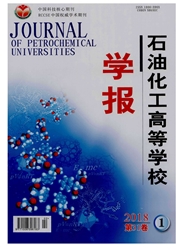

 中文摘要:
中文摘要:
采用现场举升系统结垢统计、室内铸体薄片,结合 SEM和电子探针分析了强碱三元复合驱过程中垢成分的变化和储层结垢类型与形成机理。结果表明,垢的主要类型随着强碱三元复合驱体系注入PV数的增加发生变化,注入初期以碳酸盐垢为主并含有少量硅垢和有机物,注入中期3种垢成分含量相当,注入后期结垢类型转变为与初期相同类型。铸体薄片分析表明,垢形态为白色云雾状和褐色胶结状,部分孔隙阻塞造成孔隙结构发生变化,面孔隙率平均下降6.45%。研究区垢的类型主要为钙垢和硅垢,含有少量的钡/钛垢和铁垢。由于强碱的溶蚀作用,地层和井筒中容易出现结垢现象,建议在能够实现相同提高采收率幅度的前提下可以考虑采用弱碱三元复合驱。
 英文摘要:
英文摘要:
Scaling phenomenon widely existing in the process of base ASP flooding will affected subsequent water flooding and lifting system adversely.The scale composition change and types in the lifting system and formation were studied and the scale statistics from lifting system,casting thin sections,SEM and electron probe analysis were used to determine the base ASP flooding.The results showed that the main scale types changed with the PV inj ection of base ASP flooding.In early inj ection stage,the scale was mainly carbonate scale containing a small amount of silica scale and organic matter.In the middle inj ection stage,the number component of three scales was same.In later inj ection stage,the scale was the same with early inj ection stage.Casting thin-section analysis showed that the scale form was “white clouds”and “brown cementation”.With part of the pores blocking,surface pore rate fell by 6.45% on average.The types of scale formation in the study area were mainly calcium scale and silicon scale,containing a small amount of barium/titanium scale and iron scale.Due to alkali dissolution,scaling phenomenon in formation and wellbore appeared frequently,so it was suggested that base ASP flooding should be replaced wit weak ASP flooding if it can achieve the same improving recovery rate.
 同期刊论文项目
同期刊论文项目
 同项目期刊论文
同项目期刊论文
 Experimental Study on the Molecular Dimensionand Configuration of Polymer and its Flow Characteristi
Experimental Study on the Molecular Dimensionand Configuration of Polymer and its Flow Characteristi Investigation on Mechanisms of Polymer Enhanced Oil Recovery by Nuclear Magnetic Resonance and Micro
Investigation on Mechanisms of Polymer Enhanced Oil Recovery by Nuclear Magnetic Resonance and Micro 期刊信息
期刊信息
